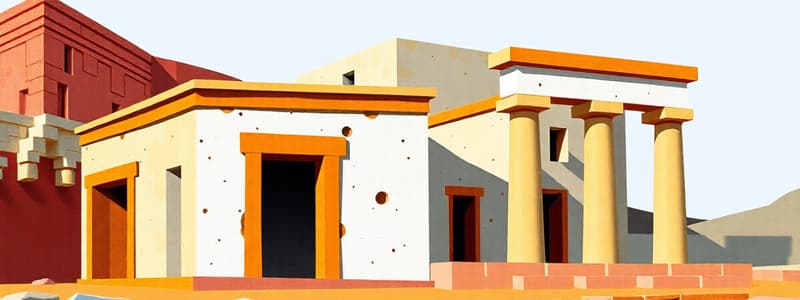Podcast
Questions and Answers
What is the primary characteristic of the Protopalatial period in Crete?
What is the primary characteristic of the Protopalatial period in Crete?
- The development of smaller, independent settlements
- The introduction of large palaces and centralized administration (correct)
- The decline of artistic expression and trade
- The absence of trade contacts with other civilizations
Which of the following materials were imported into Crete during the Protopalatial period?
Which of the following materials were imported into Crete during the Protopalatial period?
- Marble and granite
- Silk and spices
- Copper and tin
- Gold and ivory (correct)
What event is believed to have led to the destruction of palaces around 1750 bce?
What event is believed to have led to the destruction of palaces around 1750 bce?
- Earthquakes (correct)
- Invasions from mainland Greece
- Civil unrest and warfare
- A large volcanic eruption
Which palace remained functional until the end of the Neopalatial period?
Which palace remained functional until the end of the Neopalatial period?
Which stylistic change in pottery emerged during the Middle Minoan period?
Which stylistic change in pottery emerged during the Middle Minoan period?
What major change did the Neopalatial period signify in Minoan society?
What major change did the Neopalatial period signify in Minoan society?
What distinguishes Neopalatial structures from their Protopalatial predecessors?
What distinguishes Neopalatial structures from their Protopalatial predecessors?
Which of the following best describes the artistic culture during the palatial period on Crete?
Which of the following best describes the artistic culture during the palatial period on Crete?
What do the female figures on the gold intaglio seal ring represent?
What do the female figures on the gold intaglio seal ring represent?
What is the significance of the gold intaglio seal ring?
What is the significance of the gold intaglio seal ring?
Which gesture is NOT mentioned in the description of the figures?
Which gesture is NOT mentioned in the description of the figures?
What is uncertain regarding the figures depicted in the seal ring?
What is uncertain regarding the figures depicted in the seal ring?
What aspect of the scene is left as a puzzle for interpretation?
What aspect of the scene is left as a puzzle for interpretation?
How are the figures on the ring specifically formed?
How are the figures on the ring specifically formed?
Which is NOT a possibility considered regarding the small hovering figure?
Which is NOT a possibility considered regarding the small hovering figure?
What physical characteristic emphasizes the Minoan style of the figures?
What physical characteristic emphasizes the Minoan style of the figures?
What materials were primarily used in the luxury items produced during the Protopalatial and Neopalatial periods?
What materials were primarily used in the luxury items produced during the Protopalatial and Neopalatial periods?
Which entrance at the palace of Knossos was used for ceremonial processions?
Which entrance at the palace of Knossos was used for ceremonial processions?
What is characteristic of the Minoan figure known as the 'snake goddess'?
What is characteristic of the Minoan figure known as the 'snake goddess'?
What aspect of the 'snake goddess' figure showcases Minoan textile design?
What aspect of the 'snake goddess' figure showcases Minoan textile design?
What distinguishes the kouros figure found at Palaikastro?
What distinguishes the kouros figure found at Palaikastro?
How is the Minoan artistic style reflected in the physique of the kouros and snake goddess figures?
How is the Minoan artistic style reflected in the physique of the kouros and snake goddess figures?
What ritual significance is attributed to the statue of the kouros?
What ritual significance is attributed to the statue of the kouros?
What does the term 'chryselephantine' refer to in the context of Minoan art?
What does the term 'chryselephantine' refer to in the context of Minoan art?
What setting is the snake goddess figure commonly associated with?
What setting is the snake goddess figure commonly associated with?
What is the visual distinction of the 'Harvester vase'?
What is the visual distinction of the 'Harvester vase'?
What feature of Minoan figures provides a sense of dynamic motion?
What feature of Minoan figures provides a sense of dynamic motion?
Where were production centers concentrated in Minoan society?
Where were production centers concentrated in Minoan society?
What is notable about the central courtyard of the palace at Knossos?
What is notable about the central courtyard of the palace at Knossos?
What role did the north entrance of the palace fulfill?
What role did the north entrance of the palace fulfill?
What does the 'snake goddess' figure balance on her head?
What does the 'snake goddess' figure balance on her head?
What is a defining characteristic of Kamares Ware vessels?
What is a defining characteristic of Kamares Ware vessels?
During which period does Kamares Ware first appear?
During which period does Kamares Ware first appear?
What architectural feature was central to the town of Gournia?
What architectural feature was central to the town of Gournia?
What distinguishes the palace at Knossos from those at other sites like Gournia?
What distinguishes the palace at Knossos from those at other sites like Gournia?
What type of masonry is primarily associated with the construction of Minoan palaces?
What type of masonry is primarily associated with the construction of Minoan palaces?
What does Linear A indicate about the Minoan civilization?
What does Linear A indicate about the Minoan civilization?
How were the residences in Gournia primarily structured?
How were the residences in Gournia primarily structured?
What architectural element was notable in the palaces of the Neopalatial period?
What architectural element was notable in the palaces of the Neopalatial period?
What function did the palaces in Minoan society likely serve?
What function did the palaces in Minoan society likely serve?
Which of the following statements about Gournia is accurate?
Which of the following statements about Gournia is accurate?
What type of decorative art is found prominently in Minoan palaces?
What type of decorative art is found prominently in Minoan palaces?
The central courtyard in the palace at Knossos is approximately how large?
The central courtyard in the palace at Knossos is approximately how large?
What was one of the primary materials used in the walls of the Minoan palaces?
What was one of the primary materials used in the walls of the Minoan palaces?
Flashcards are hidden until you start studying
Study Notes
Minoan Civilization Overview
- Middle Minoan Period: Known as Protopalatial, spanning c. 1900–1750 BCE, marked the rise of large palaces across Crete.
- Palace Architecture: Featured large central courtyards surrounded by multi-story buildings, indicating centralized administration and wealth.
Trade and Economy
- Trade Expansion: Increased trade evidenced by imported gold and ivory as well as the export of Kamares Ware pottery to Egypt.
- Redistribution System: Palaces likely served redistributive functions, gathering resources from the surrounding territories.
Phases of Minoan Architecture
- Destruction and Rebuilding: Palaces destroyed around 1750 BCE, potentially by earthquakes, then rebuilt larger during the Neopalatial period (c. 1750–1490 BCE).
- Knossos Palace: Largest Minoan palace, designed around a rectangular courtyard measuring 25m x 50m, featuring multiple stories and complex architectural elements.
Minoan Pottery
- Kamares Ware: Characterized by dark slip backgrounds with vibrant motifs in white, yellow, and red; signifies artistic innovation during the Protopalatial period.
- Pottery Techniques: Use of wheel throwing and complex decoration techniques enhances the visual appeal of functional items.
Settlement Patterns
- Gournia Town: A smaller settlement with a central open square, modest palace serving administrative functions, showcasing increased urban population and complexity.
- Residential Architecture: Houses varied in configuration, typically two stories with communal and storage spaces.
Artistic Developments
- Sculpture and Figure Art: Prominent figures include the "Snake Goddess" and the kouros from Palaikastro, both reflecting Minoan styles featuring narrow waists, vibrant colors, and dynamic poses.
- Material Use: Faience, ivory, and chryselephantine materials suggest artistry and luxury, with cult-value implications.
Writing and Administration
- Linear A: Undeciphered script developed during the Protopalatial period, used for administrative purposes, indicating sophisticated governance and economic management.
Significant Cultural Shifts
- Centralized Administration: Marked shift from Early Minoan less complex societies to more organized and specialized production based in palatial structures, indicative of elite culture.
- Artistic Legacy: Minoan art reveals vibrant representations of human figures and rituals, influencing later Greek artistic traditions.
Ritualistic and Symbolic Art
- Religious Practices: Unclear relationships within represented figures in rituals, showcasing the integration of divine and mortal aspects in artistic expressions.
- Cultural Symbols: Objects like intaglio seals serve both an administrative function and reflect the elite status of their owners through intricate design and scenes.
Studying That Suits You
Use AI to generate personalized quizzes and flashcards to suit your learning preferences.




